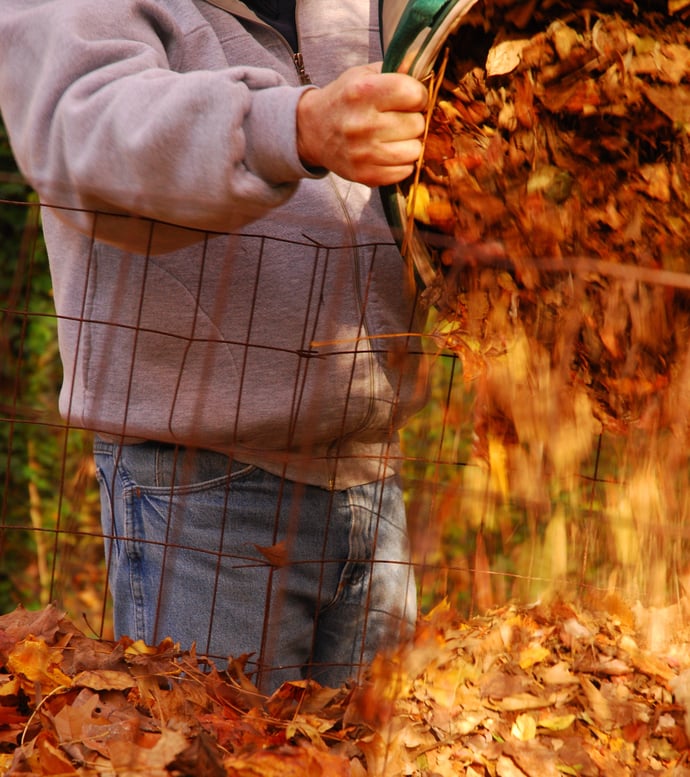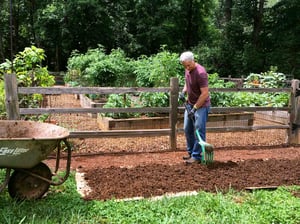Leaves put on a beautiful display as they change in autumn from green to yellow and red, but I enjoy seeing fall leaves the most after they’ve fallen to the ground and been raked up into a big pile — because I know how valuable leaves are to my garden.
Don't Bag Leaves - Put Them to Work in Your Garden
Rather than sending those leaves — and their value — away to a landfill, you can put them right back to work in your landscape as organic mulch or, given time, compost. First, we'll talk about the value in your leaves, then we'll talk about what to do with them in your garden.
- Soil Insulation: Leaf mulch insulates the soil to keep the temperature more consistent. Generously applied mulch will keep soil cool during hot spells, and in cold climates, it will prevent soil from heaving due to freezing and thawing.
- Soil Moisture Retention: The leaf mulch also retains moisture in the soil so you can water less, and it prevents soil erosion in heavy rain. And because mulch blocks sunlight, weed seeds underneath can’t germinate.
- Soil Improvement: On top of all of these benefits that you begin to realize as soon as leaf mulch is applied, leaves improve soil tilth — the soil’s texture, drainage, and suitability for sowing seeds — as they slowly decompose. When leaves are applied year after year, a plot that started out with heavy clay or fast-draining sand will eventually be transformed into rich, loamy soil.
- Nutrient Cycling: Around 50 to 80% of the nutrients that trees take up from the soil below are stored in the leaves. Don't send those nutrients to the landfill, put them right back into your soil (and then through to your plants) by using them for mulch or compost material.
While raking and shredding leaves from my own lawn in the fall is an option, I prefer to recover leaves bagged by neighbors and set out curbside for trash pickup. That way, I am diverting those leaves from the landfill. I used to shred more of these but have learned that keeping them intact is essential for overwintering insects, such as critical pollinators. Now I shred only about 20% for specific mulching needs in the garden (such as around small plants), while leaving the other 80% unshredded as mulch in my ornamental beds.

Raking leaves from your lawn is important, but keep them on your property by using them as mulch or in compost.
Use Leaves as Mulch
Once they are raked up from my lawn, driveway, and paths, I either apply the leaves to my garden beds as mulch if needed, or store them in my “leaf corral” and allow them to slowly break down until I’m ready to use them later.
You can even leave them in place, right where they fall, in ornamental beds and natural areas.
Adding leaves to my leaf corral.
In your landscape beds, rake, blow or hand apply a 2-inch layer of leaf mulch on the soil surface. If you wish to weigh the leaves down so they don’t get displaced in the wind, you can apply pine straw or woodchips over the leaves — but this is completely optional. Just don’t mulch deeper than 4 inches in total. All of these organic materials will decompose to provide nutrients to your plants with the help of earthworms and soil microbes.
If you’d like to learn more about “leaving the leaves” on your property, head over to my podcast all about how fall leaves are important for wildlife and the climate. (That's a link to the podcast.)
Add Leaves to Your Compost Pile
If you find you have leaves left over after mulching your gardens, that’s great, because leaves are a priceless addition to your compost pile. Dry leaves are mostly carbon and are considered a “brown” in composting terms. When leaves are mixed with water and nitrogen-rich “greens,” such as grass clippings, coffee grounds, and vegetable scraps, compost piles activate, heating up due to the microbial activity that transforms the inputs into earthy humus.
Read my article on The Soil Food Web: Build a Relationship Between Your Plants and Soil to find out why adding compost, both your own and Soil³ compost, is so important for your plants.
You can use most any fall leaves as mulch or in compost, but there are few to be careful of.
- Some leaves, like those from oak trees, take a prolonged amount of time to decompose. This is because they contain high amounts of lignin, the organic polymer that makes wood, bark and, in the case of oaks, even the leaves rigid and slow to break down. When using oak leaves as mulch, it is especially beneficial to shred them first. Oak leaves are also acidic, but as long as you don’t till them in, the effect on the soil pH will be negligible.
- Black walnut leaves pose a problem that is much more difficult to overcome: They contain a high concentration of juglone, a chemical found in all walnut trees that is toxic to other plants. Juglone will break down only when the leaves are thoroughly decomposed, so black walnut leaves and woodchips are never recommended for mulch.
With all this in mind, the next time you’re raking leaves, maybe it won’t feel like as much of a chore. There’s satisfaction in knowing their value to your garden.
Plus, if we all “close the loop” by keeping leaves on our properties to feed our soil and nourish our plants, we can collectively reduce landfill waste by more than 10%.











Did this help you out? Have any questions for clarity? Leave a comment below!